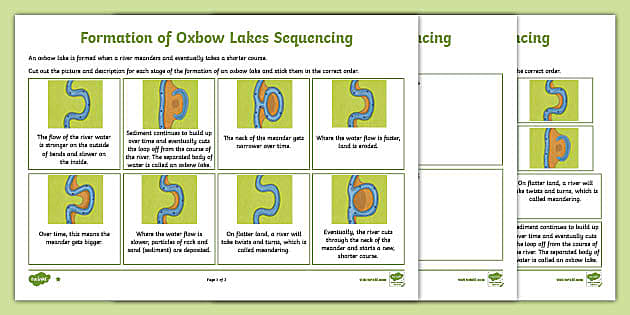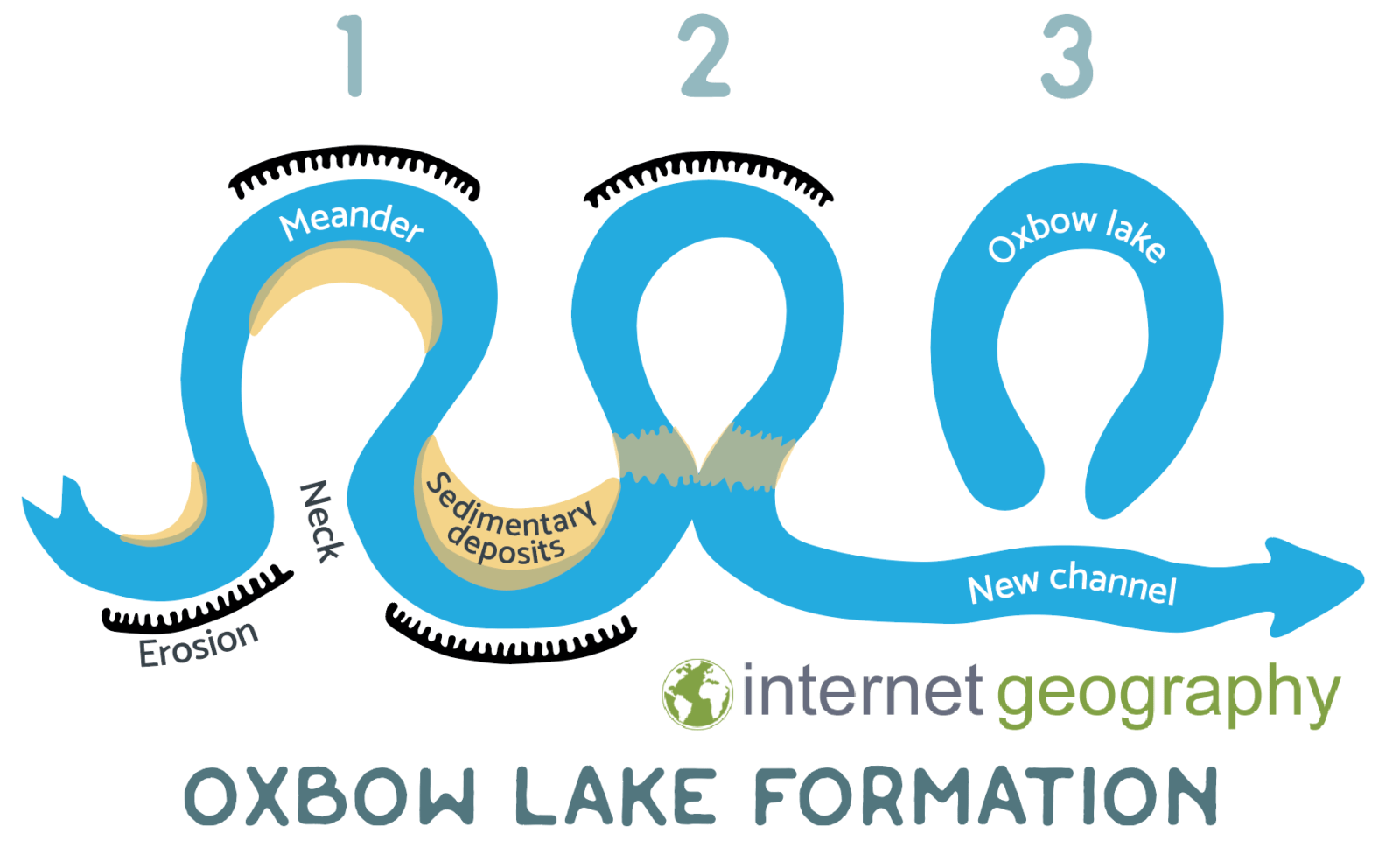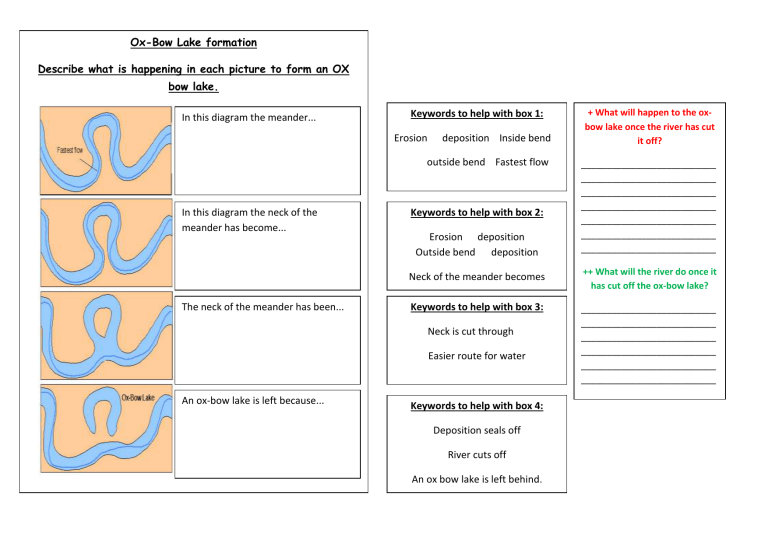Describe the Formation of an Oxbow Lake
Learn how to define an oxbow lake explore how they are formed. An Oxbow lake is essentially formed when a meandering river has its flow cut off by sediment deposition.

Meanders And Oxbow Lakes Geographyalltheway Com
Oxbow lakes form through the following steps.

. Oxbow lakes are most commonly found in the middle course of the river where the river has more energy and higher discharge. A meander is first formed as a result of deposition and erosion - velocity is higher on the outside bend which means erosion occurs forming a cliff face. Oxbow lake formation in a meandering stream.
It is generally formed as a river cuts through a meander neck to shorten its course causes the old channel to be rapidly blocked off and then migrates away from the lake. Question 19 5 pts Describe and explain the formation of an oxbow lake on a stream floodplain. An oxbow lake forms when a curve or meander in a river pinches shut.
Tooth in Treatise on Geomorphology 2013 14531 Reach-Scale Fluvial Geomorphology. A river meanders because of obstacles and patterns of erosion and deposition of sediments. How does an oxbow lake form.
Explain the formation of an oxbow lake. 2 As river meanders become more pronounced and curved the two outside banks of one or two meanders may eventually. They are features of both erosion and deposition.
As the water erodes at the neck material deposits at the opposite point of erosion. Due to erosion on the outside of a bend and deposition on the inside the shape of a meander will change over a period of time. An oxbow lake forms when the strip of land that seperates parts of a meander is eroded.
Oxbow lake small lake located in an abandoned meander loop of a river channel. When a meander or loop. Over a given period of time this process repeats until eventually the river becomes.
Deposition occurs on the inner bend as a result of slower velocity forming a slip off slope. Migrating streams erode the landscape. The speed of the flow cuts away the outside bank of a loop in a process called erosion.
An oxbow lake forms when a meander or curve in the waters course gets cut off from the main river leaving a U-shaped lake behind. FORMATION OF OX-BOW LAKES. Ox-bow lakes are found in the middle and lower course of the river where lateral erosion is significant.
When you get a meander the lake slowly erodes from the inside because water will always want to take the faster route which would be straight the lake will slowly cute off the meander while dumping the rivers load forming an oxbow lake. Oxbow lake refers to the remnant part of the erstwhile meandering stream which has been cut off from the main channel due to the stream straightening process View the full answer Transcribed image text. Flooding in 1877 formed Carter Lake in Iowa an oxbow of the Missouri River.
1 Rivers meander because of the processes of erosion and deposition where sediments are taken away from the bank of. A Floodplain is a wide flat or nearly flat land over which the stream moves. They are called oxbow lakes due to their curved shape which resembles a bow or horse-shoe shape.
The river follows a new shorter course and a lake forms beside the river. An oxbow lake is a lake that forms when a meander in a river is cut off from the rest of the river. Phil Reiker NPS Geologic Resources Division.
It is also actually and. In South Texas oxbows left by the Rio Grande are called resacas. It is shaped like a crescent or the bow of an oxen yoke.
The lakes are formed by what were once bends or large curves in winding river systems and as such can be found in groupings in some areas. Meander Ox-bow lake Deposition Erosion 2. View the full answer.
This is the middle part of a rivers journey. Oxbow lakes are a curious geographic phenomenon that can be found in various countries around the world. Formation of erosional and depositional features in river landscapes.
The water flows fastest around the outside of the bend and slower on the inside. Oxbow lakes are U-shaped or curved bends in a river that are cut off from the main river flow forming a lake. 1Straight river channel usually starts to follow meandering or curved pattern after a long course of flow.
As a river reaches flatter land it swings from side to side forming winding bends called meanders. Most water is directed towards the outside bend there is also reduced friction and increased velocity. An oxbow also refers to the horseshoe-shaped bends in rivers that can eventually become oxbow lakes.
An oxbow lake is a uniquely shaped lake resulting from the path of a meandering river. Erosion narrows the neck of the land within the meander and as the process continues the meanders move closer together. Growth of meander bends and eventual bend cutoff are key processes in the formation of oxbow lakes and the construction of meandering river floodplains but few quantitative data are available to describe and explain how the meandering process populates the floodplain with oxbow lakes.
If only one loop is cut off the lake formed will be crescent shaped whereas if more than one loop is cut off the lake will be. The river is meandering across the valley and erodes laterally. The Outer bend of a river is where the velocity of the river flow is highest hence the bank is eroded away.
An oxbow lake is a U-shaped lake or pool that forms when a wide meander of a river is cut off creating a free-standing body of water. They are formed from Meanders. This leaves the meander loop cut off as an oxbow lake.
The formation of an oxbow lake is formed at a meander an example of this is the cuckmere river. We review their content and use your feedback to keep the quality high. In Australia oxbow lakes are called billabongs.
2Due to erosion and deposition as shown in the figure the velocity gradually drops down. When the tightly curved portion of the stream is cut off an oxbow lake develops off from the main river system. This lake is eventually filled by sediment through river flooding.
The banks of the curves closest to one another the concave banks are prone to erosion from the force. The word oxbow can also refer to a U-shaped bend in a river or stream whether or not it is cut off from the main stream. The meander neck also gets narrower as materials deposit and soon cuts off the bend.
1Oxbow lake usually forms in mature stage of river. How do oxbow lakes form. Conversely the inner bend of a river has lower velocity so sediment is deposited.
Oxbow lakes form when a river has two curves one bending away from the straight course and another bending back. Meander a bend in a river 3. A meandering stream has a single channel that winds snakelike through its valley so that the distance as the stream flows is greater than as the crow flies As water flows around these curves the outer edge of water is moving faster than the inner.
Oxbow Lakes Meander neck becomes smaller new course of the river oxbow lake When the river floods it breaks through the thin meander neck and the river takes the easier straight course. The formation begins with erosion at the meander neck this type of erosion is called hydraulic action.

Draw A Simple Diagram To Show The Formation Of An Oxbow Lake Internet Geography


0 Response to "Describe the Formation of an Oxbow Lake"
Post a Comment